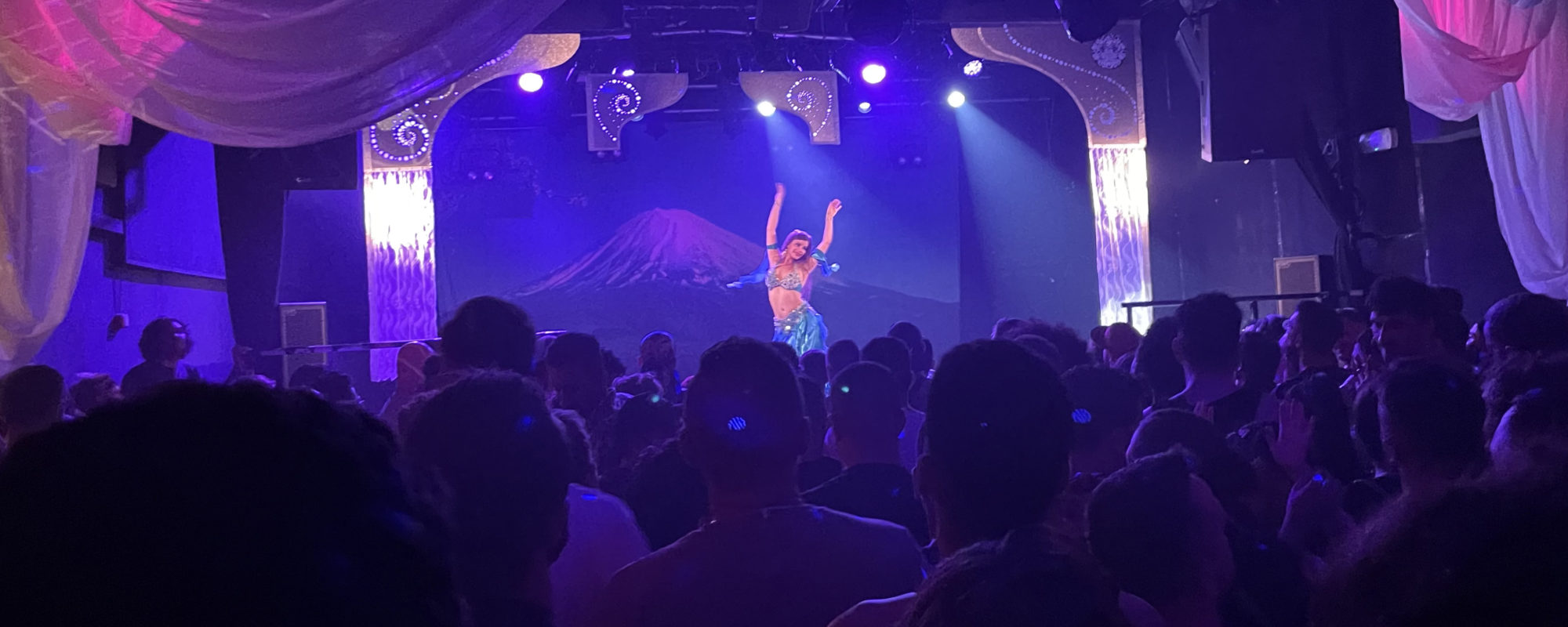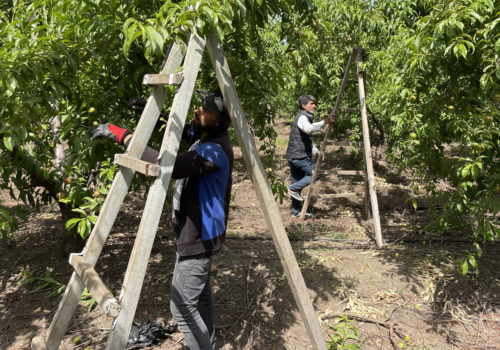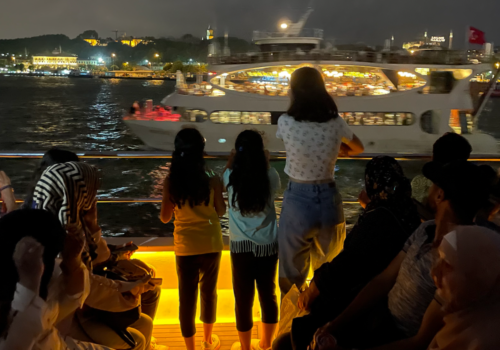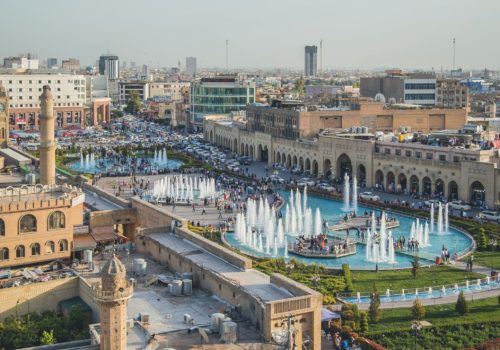BERLIN — On a sweltering summer day in July, nearly 400,000 partygoers flocked to Berlin’s Christopher Street Day Parade—one of the world’s most prominent celebrations of pride for lesbian, gay, bisexual, transgender and other sexual and gender minorities. The sounds of ABBA and David Bowie boomed from parade floats as crowds heeded the latter’s manifesto: Let’s Dance! The scene was full of rainbow confetti, sequins and flesh.
In front of the Brandenburg Gate, a belly dancer and artist who goes by The Darvish [1] took to the parade’s main stage dressed in a silver and white dress and a chrome tarboosh hat. “I’m here as a Syrian. I’m here to stand and say the fight is yet to come. I want all of this to be in Syria!” The Darvish called out to the crowd before breaking into a zaghrouta, or ululation.
“It’s important to show that these refugees, these people, they are people,” The Darvish said over a booming recording of the popular Syrian singer Omar Souleyman. It was the first time a Syrian had headlined any major Pride event in the city.
Berlin has long been a queer capital but more recently it’s also become a home for 40,000 members of the Syrian diaspora. In my conversations with some of them, I found no easy consensus on whether Syrians at large have formed a community here. Many are still preoccupied with the transition from refugee to resident. But for those who identify as LGBTQ+, a clearer narrative emerged.
Dania Najari, a Syrian with a sweet round face and curly black hair in her early 20s, put it simply: Just as there is no unified Syrian diaspora in Berlin, there is no one Syrian queer community. Rather, she said, imagine a raft of social bubbles which sometimes merge or split, all in dynamic interplay.
Berlin appears to be a home of emancipation. Queer Syrians described—for the most part—feeling safe although not necessarily seen. They are now working toward greater representation in both societies to which they belong: Syrian and German.
Back in Syria, although same-sex behavior is often described as a foreign import, Syrian and Islamic history are rife with examples of communities that long enjoyed varied sexual practices, from the sixth Abbasid caliph Muhammad al-Amin, who some sources claim was known to sleep with men, to the ribald classical Arab poet Abu Nawas, who described his love for young men. In interviews, Syrian transplants told me about going to queer-friendly places public and private, and underground parties in many of their home country’s big cities.
Still, there is a lack of basic recognition, tolerance and safety for the LGBTQ+ community in Syria. “Don’t ask, don’t tell,” one Syrian in Berlin told me. Homosexuality was criminalized with Article 520 of the Syria’s Penal Code of 1949, with prison terms of up to three years. The country’s Islamic and Christian authorities also explicitly forbid gay sex.
In 2011, the Syrian uprising initially brought hope for greater freedoms, including for the LGBTQ+ community. The reality of war, however, proved otherwise. Even as widespread displacement led to exposure to social norms in other countries, the war has helped to enforce and sometimes magnify conservative social norms. ISIS, the Syrian government and an alphabet soup of other armed groups have persecuted queer and trans Syrians, with ISIS deploying especially brutal methods of repression like public stoning.
Those exiles who made it to Berlin are experiencing a different historical narrative. During the period between the world wars, the city became Europe’s gay mecca. Even as the Nazi Party violently (and selectively) encouraged homophobia, sending men accused as homosexuals to concentration camps, Berlin still hosted wartime lesbian balls. The city’s culture was especially ahead of its time in recognizing nuances around sexual and gender identity. Homosexuality was decriminalized in Germany in 1969, laying the foundation for today’s culture. It was also the first European country to legalize a third gender.
* * *
Now, less than a decade after they began arriving in force, Syrians have become the third-largest group of foreign nationals in Berlin after Turks and Poles. They include many intellectuals, artists, queers and young people who have joined substantial Lebanese and Palestinian communities to make the city a new capital of culture for Arab exiles.
Berlin formally deems LGBTQ+ exiles a “vulnerable group” eligible for asylum. Although there is no public data about the number of queer Syrians in the country, conversations inside and outside the capital confirmed the city’s reputation as a magnet. “Berlin was being advertised as where you can live your true self, where all your kinks and fetishes are celebrated, not something to be ashamed of,” Tarek, an engineer in his thirties originally from Damascus, said.
However, being both queer and a migrant is a vulnerable combination. The Lesbian and Gay Association, a German organization helping those seeking asylum for reasons related to sexual orientation or gender identity, says Syrians made up more than a 10th of the organization’s beneficiaries last year. The number was even higher from 2015 to 2018 during German Chancellor Angela Merkel’s open-door policy. However, the association’s Lucina Akintaya says queer migrants face challenges many others don’t. “We are doing our best to provide a safe space, but the intersectionality of our mentees still creates more challenges for society to discriminate against.”
* * *
Many queer Syrians told me Berlin is no haven. Each had stories about discrimination, from homophobic and transphobic slurs to sexual harassment. In 2017, the far-right Alternative for Germany Party entered parliament on a platform to close the country’s borders to asylum seekers; their members have also called for repealing gay marriage and even imprisoning homosexuals. Hate crimes against LGBTQ+ people rose 36 percent in 2020, the government reported, to a total of 782 crimes, 150 of them violent.
“Even today, people belonging to the LGBTQ+ community are excluded and even physically attacked,” Berlin Mayor Franziska Giffey said at the recent Christopher Street Day Parade. That same night brought at least two reported homophobic attacks in the city.
Most queer Syrians I met said they feel most unsafe in predominantly Syrian and other immigrant neighborhoods. Along Sonnenallee—known colloquially as “Arab Street” in Neukölln, a heavily migrant neighborhood dominated by Arabs and Turks—queer Syrians explained how they have learned to change behavior as they move in and out. They avoid holding hands, speak only in English, use headphones to block out unwanted sexualized comments and try to avoid visibly flamboyant markers.
“It’s not safe to be you,” Michaela Daoud said. The queer transgender Syrian artist who moved to Berlin in 2015 described daily harassment walking along Sonnenallee. Like many Berliners who face an uphill battle to find an apartment, Daoud did not have much choice in housing and ended up in the bustling Arabic-speaking area. Although daily persecution takes a toll, Daoud also described deep feelings of connection surrounded by familiar sights and sounds from back home. “Sonnenalle makes me feel me. I don’t feel safe but also don’t want to leave.”
Although laws are in place to protect the queer community, some Syrians say German law enforcers turn a blind eye to transgressions inside immigrant enclaves. “What do you expect?” Tarek K recalled being told by a German friend.” They just came from war. Don’t go to Neukölln if you are gay.” Many queer Syrians see a double standard and argue the law should be uniformly enforced.
Sometimes discrimination comes from the larger Berlin queer community. A 20-something Palestinian Syrian artist, Zain, described applying for a job on an online LGBTQ+ group. After agreeing to review his resume, a native Berliner invited him to a sauna, where he made several unwanted advances. Afterward, Zain described feeling confused about whether to report the incident. “What am I supposed to do? Go to the police? I am a six-foot brown habibi,” he said, using a term of endearment. The episode rattled his trust in Berlin. “Is this a safe space or a gay cruising site?” he said.
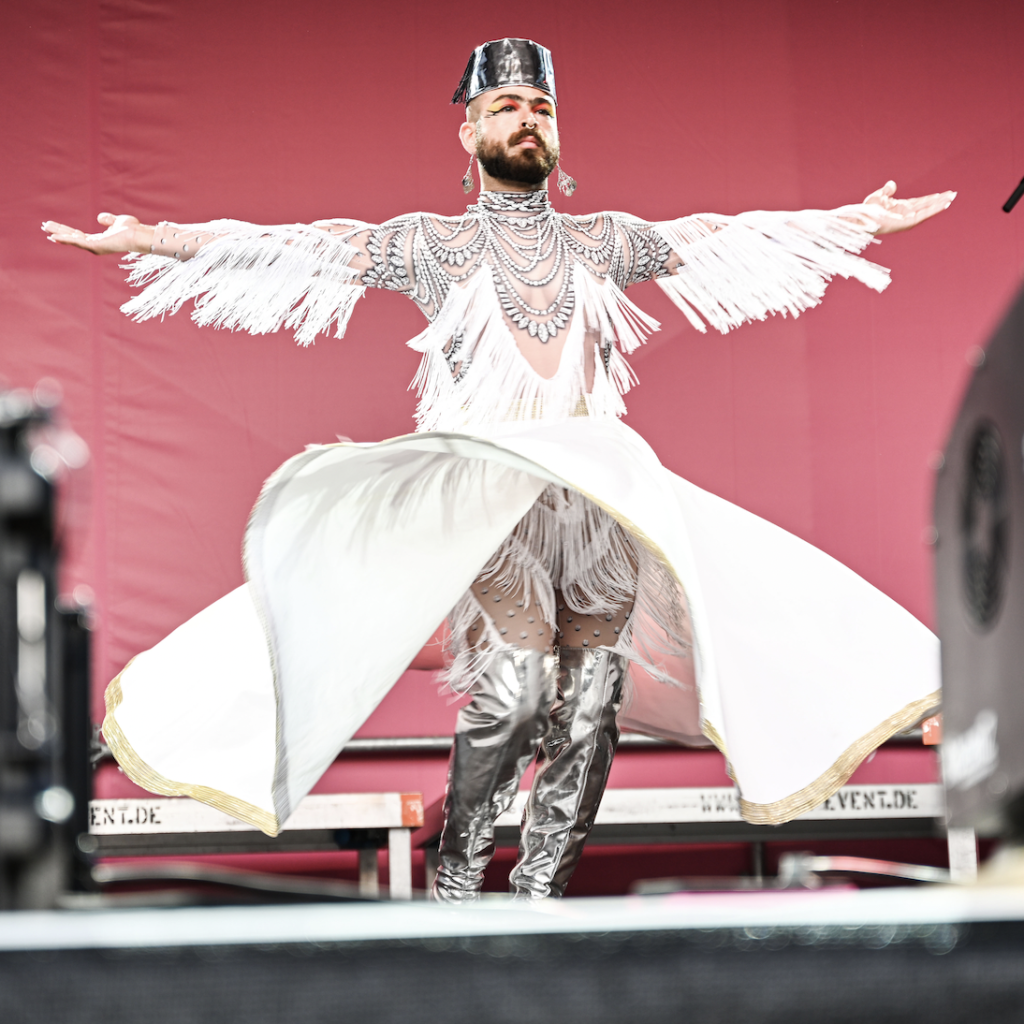
The Darvish had imagined being on that main stage since he arrived in Berlin six years ago and attended his first Christopher Street Day Parade. “Being on that stage and taking up space in my new hometown has been one of the most important days for me here,” The Darvish said after the performance.
Back in the port of Latakia on Syria’s coast, The Darvish had lived a double life, joining in the underground queer scene while heeding frequent calls to “dim it down” in public life. Today, he says his performances aim to translate past traumas into joyful dance.
But The Darvish knows first-hand the difficulties for Syrians in Berlin’s queer scene. With his colleague Olympia Bukkakis, he helps host the Queens Against Borders collective, which organizes performances, fundraisers and self-defense classes, in order to build solidarity among trans and queer refugees, and help others find a platform for self-expression.
“I knew who I was from a young age. But Berlin has amplified who I am,” The Darvish said.
Not all queer Syrians said they feel represented at the Christopher Street Day Parade, however. “It’s too white. It’s too corporate, and there aren’t enough lesbians,” Dania Najari told me. Instead of attending the parade, she and her girlfriend went to a demonstration called “Internationalist Queer Pride for Liberation” in Hermanplatz, a square where the immigrant and hipster-rich neighborhoods of Neukölln and Kreuzberg meet. There, crowds marched against “pinkwashing parades and rainbow capitalism,” while some conservative Arabs in the neighborhood jeered.
“Pride is not about partying. It’s about demonstrating,” Dania said. She added that she has found it hard to make friends with queer Germans but feels at home demonstrating with queer communities of color. “Some of my queer Syrian friends are happy we are safe. But that is not enough. We need to make this a home here.”
* * *
Digital community—seen as more private, secure and not bound by geography—can play a key role in larger social progress. Or at least that’s what Ian AlKadi, founder of the popular online platform LGBT in Arabic, thinks. Originally from Damascus, he sought to fill a gap he noticed during his own early experiences. “If you only know Arabic and search ‘Is it normal to be gay?’ The available sources will say you are abnormal.” LGBT in Arabic now has more than 100,000 followers.
Ian and his team have also launched several online campaigns for greater visibility on their platform. The most successful was a photo series, “One of You,” in which hundreds uploaded photos of the rainbow flag painted on their ring fingers with the expression “One of You” written on their palms. Photos were taken in front of monuments and cityscapes in Damascus, Homs, Latakia, Qamishli and other Syrian cities, and others around the world. The campaign prompted debate across all kinds of Syrian media outlets. “Sure, there was negativity against us, but there is no bad publicity,” Ian said.
Dina Aboul Hosen, a journalist from As Suwayda in southwest Syria, has also led online community-building. One night in Berlin after witnessing a series of young Syrians reportedly die from heart attacks in Berlin’s cold winter months, she created the Facebook group called Qalbi, Qalbak (My Heart is Your Heart) where Syrians discuss mental health and suicide. By the next morning, hundreds of conversations had taken place. Today, Dina’s group has nearly 30,000 active members across Syria and the diaspora.
Conversations on the group run the spectrum from posts expressing curiosity over bisexuality to arguments between parents and children about whether to accept LGBTQ+ people to conspiracies purporting that Western countries have welcomed Syrians in order to brainwash them into becoming homosexuals. At the same time, Dina has seen steady progress in expressions of tolerance. “It’s like a train, not moving fast, but we are still moving,” she said. Exposure to different values may be the one good development that came out of the massive displacement of Syrians globally, she said.
* * *
Queer Syrians expressed fatigue over their interactions with other Berliners. Some Germans took no interest in them, while others were only too eager to hear what was happening back in Syria. “Even your fingers on one hand are different so how can I represent an entire country?” said Ali Shrieka, a muscly 28-year-old queer Syrian with a manicured beard.
He and others described the everyday discrimination they face, as well as assumptions that they couldn’t fully explore their identities until arriving in Berlin.
“The queer scene back in Syria was secretive but extremely authentic,” Michaela Daoud said. As for Berlin, the city offers many escapes, Daoud said—which friends of his have used in both healing and less healthy ways.
Syrians also often feel pigeonholed into a narrative of trauma.
“Many of us want to be seen as me, not me plus my background,” Tarek K said.
Life in Berlin also has new social pressures. “Everyone has their own pronouns,” Ali said. “Do what you want, but don’t force them on me. Here you are told you are not political enough. You don’t party enough. You are not feminine enough. You are only top. You are only bottom. Let me be who I want to be.”
But others say Syrian exiles in Berlin have already come a long way. Wael, a Syrian playwriter, described the lack of a single, unified community as a good thing.
“Nothing is unexpected anymore,” he said. “What you see versus what you didn’t see. There is Pride and there are alternatives. You can protest for certain intersectionality, or you can go party with corporate money. Heterogeneity is the way forward.”
Endnotes
[1] In the article, some interviewees requested only part of their name be used to protect their privacy.
Top photo: Gayhane, Berlin’s “HomoOriental Dancefloor” buzzes with a polyglot mix of Syrian and other Arabic dialects, Turkish, Farsi and more. The crowd swirls to rhythmic synth sound of Levantine and Halay folk dance and Egyptian rap. The atmosphere is kinetic and warm as a transgender belly dancer begins to perform

